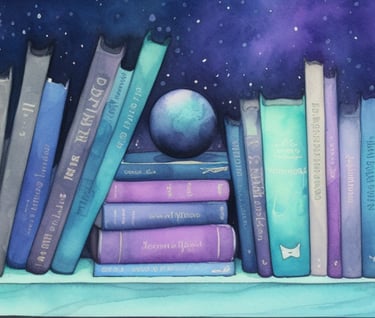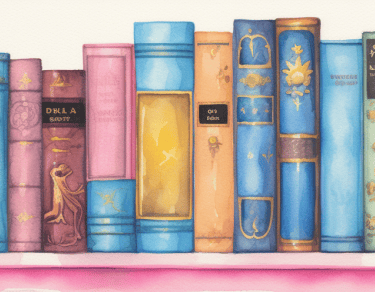Building Inclusive Worlds: A Guide to Neurodiverse Settings in Fiction
Embracing Diversity in Storytelling: Crafting Authentic Neurodiverse Characters and Settings in Fiction
DIVERSITYCREATIVITYWRITINGWORLD BUILDING
Kat Sanders
8/19/20239 min read


The importance of neurodiverse representation in fiction goes beyond a fleeting trend. It's a vital aspect of authentic storytelling that resonates with a broader audience and contributes to a more empathetic and understanding society.
Neurodiversity refers to the vast spectrum of human cognitive differences and recognizes that variations in the human brain are natural and valuable. It includes conditions such as autism, ADHD, dyslexia, and more. In our diverse society, understanding and embracing neurodiversity is not just a progressive ideal; it's a fundamental acknowledgment of human complexity and individuality.
In the realm of fiction, where worlds are crafted to mirror, challenge, or reimagine our own, the representation of neurodiversity is often lacking or misguided. Authentic portrayals of neurodiverse characters are essential for reflecting the true diversity of human experience, and for fostering empathy and inclusivity among readers.
By understanding and implementing neurodiversity in our creative works, we can build richer, more inclusive worlds that resonate with a broader audience, and contribute to a more empathetic and understanding society.


Understanding Neurodiversity
Neurodiversity is a term that encompasses a wide range of neurological conditions and differences, recognizing that variations in the human brain are natural and valuable. Some common neurodiverse conditions include autism, ADHD (Attention Deficit Hyperactivity Disorder), dyslexia, and others. Each of these conditions has unique characteristics, but they all share the commonality of being part of the diverse spectrum of human neurology.
The Importance of Avoiding Stereotypes and Misconceptions
When portraying neurodiverse characters in fiction, it's crucial to avoid stereotypes and misconceptions that can lead to harmful representations. For example, not all individuals with autism are savants, and not everyone with ADHD is wildly impulsive. These stereotypes can perpetuate misunderstandings and stigmas, undermining the authenticity of the portrayal. Research, consultation with experts, and engagement with neurodiverse communities can help in crafting characters that reflect the true diversity and individuality of neurodiverse experiences.
Historical Perspective on Neurodiverse Representation in Literature and Media
Historically, neurodiverse representation in literature and media has been fraught with challenges. Characters with neurodiverse conditions were often portrayed in a one-dimensional manner, reduced to their symptoms, or used as plot devices rather than fully developed individuals. The portrayal was often far from authentic, leaning into stereotypes or sensationalism.
However, in recent years, there has been a positive shift towards more nuanced and respectful portrayals. Authors, filmmakers, and creators are recognizing the importance of authentic representation, and some are even identifying as neurodiverse themselves, bringing their personal experiences into their work.
Understanding neurodiversity is not just about recognizing different conditions; it's about embracing the rich tapestry of human experience and reflecting it in our stories. By avoiding stereotypes, honoring individuality, and acknowledging the historical context, we can create narratives that resonate with readers and contribute to a more inclusive and empathetic world.


Creating Authentic Neurodiverse Characters
Crafting neurodiverse characters that resonate with readers requires more than just assigning a condition or trait. It demands a deep understanding, empathy, and a commitment to authenticity. Here's how to approach the creation of well-rounded neurodiverse characters:
Tips for Developing Well-Rounded Neurodiverse Characters
Research Thoroughly: Understand the specific neurodiverse condition you're portraying. Read literature, consult experts, and engage with neurodiverse communities.
Create Individuality: Treat neurodiverse characters as unique individuals, not defined solely by their neurodiversity. Consider their personality, background, interests, and relationships.
Show, Don't Tell: Rather than explicitly stating a character's condition, show it through their actions, thoughts, and experiences.
Avoiding Clichés and Stereotypes
Move Beyond Stereotypes: Steer clear of one-dimensional portrayals that reduce characters to stereotypes or clichés.
Build Multi-Dimensional Characters: Create characters with depth, interests, flaws, and strengths that go beyond their neurodiversity.
Avoid Sensationalism: Handle neurodiverse characters with sensitivity, avoiding sensationalism or exploitation.
Incorporating Intersectionality
Neurodiverse individuals come from diverse backgrounds, and their experiences are shaped by various factors such as race, ethnicity, gender, and more. Recognize that neurodiverse characters may have other intersecting identities that influence their experiences. Reflect real-world diversity, considering how different aspects of their identity interact.
The Role of Sensitivity Readers and Consulting with Neurodiverse Individuals
Engage Sensitivity Readers: Consider hiring sensitivity readers who specialize in neurodiversity to review your work. They can provide insights and feedback to ensure an authentic portrayal.
Consult with Neurodiverse Individuals: Seek input from neurodiverse individuals within your community or online forums. Their personal experiences and perspectives can enrich your character development.
Creating authentic neurodiverse characters is a journey that requires diligence, understanding, and a willingness to learn. By embracing individuality, avoiding clichés, recognizing intersectionality, and engaging with neurodiverse communities, you can craft characters that not only enrich your fictional realms but also resonate with a broader audience. The characters you create have the power to inspire, connect, and foster a more inclusive and compassionate world. Let's wield that power with care and creativity.


Building Inclusive Settings and Cultures
Creating fictional worlds that reflect neurodiversity is about more than just individual characters. It's about constructing entire societies, cultures, laws, and norms that embrace neurodiversity. Here's how to approach this multifaceted task:
How to Create Fictional Societies that Reflect Neurodiversity
Inclusive Societies: Build societies that celebrate neurodiversity, reflecting acceptance and equality. Consider how neurodiverse individuals fit into different roles, professions, and social structures.
Varied Cultural Norms: Recognize that different cultures within your world may have different attitudes and norms regarding neurodiversity. Explore these variations to create a rich and complex world.
Symbols and Traditions: Incorporate symbols, festivals, and traditions that honor neurodiverse history and culture, making them an integral part of the societal fabric.
Considerations for Laws, Rights, Education, and Social Attitudes
Laws and Rights: Consider the legal status of neurodiverse individuals, including rights, protections, and accommodations.
Social Attitudes: Explore how society views neurodiversity, reflecting both acceptance and potential challenges or biases.
Educational Systems: Consider how neurodiversity is understood, taught, and accommodated within the educational systems of your world. Think about specialized programs, teaching methods, and societal awareness.
The Balance Between Idealized Inclusivity and Realistic Conflicts
Realistic Conflicts: While creating inclusive worlds, recognize that conflicts and challenges may exist. These can be societal biases, misunderstandings, or systemic barriers.
Avoiding Exploitation: Handle conflicts with sensitivity, avoiding sensationalism or exploitation of neurodiverse struggles.
Reflecting Real-World Issues: Use conflicts to shed light on real-world issues, providing insight and empathy without stereotyping or oversimplification.
Idealized vs. Realistic Portrayals: Strive for a balance between portraying an idealized inclusive society and the realistic challenges that might exist. This balance can add depth and complexity to your world-building.
Building inclusive settings and cultures that reflect neurodiversity is a rewarding and essential aspect of authentic storytelling. By infusing every part of your world with inclusivity, from legal systems to cultural traditions, you not only enrich your storytelling but also send a powerful message of acceptance and empathy. These fictional realms can become mirrors of the world we aspire to live in—a world where neurodiverse individuals are celebrated, understood, and embraced in all their complexity. Let's continue to craft worlds that reflect this vision, inspiring readers to imagine a more inclusive future.


Storytelling and Plot Considerations
Crafting a compelling story that integrates neurodiverse themes requires careful consideration and intention. It's not just about adding characters or elements but weaving them into the very fabric of the story. Here's how to approach this vital aspect of storytelling:
Integrating Neurodiverse Themes into the Main Storyline and Subplots
Main Storyline Inclusion: Ensure neurodiverse themes are woven into the main plot, making them central to the story's conflict, resolution, or theme.
Relevance and Purpose: Make sure neurodiverse elements serve a purpose in the story, contributing to character development, plot progression, or thematic exploration.
Subplot Integration: Create subplots that explore neurodiverse themes, ensuring they are relevant and enrich the overall narrative. Consider how neurodiversity might influence relationships, challenges, or personal growth within the story.
Avoiding Tokenism and Ensuring Meaningful Inclusion
Beyond Token Characters: Avoid including neurodiverse characters or themes merely for the sake of diversity. Each character and element should have depth and purpose.
Meaningful Inclusion: Ensure that neurodiverse elements are meaningful to the story, not superficial or stereotypical. This might involve exploring unique perspectives, challenges, or strengths related to neurodiversity.
Consultation and Sensitivity: Consider consulting neurodiverse readers or sensitivity readers to ensure authentic and respectful portrayal.
The Impact of Neurodiversity on Relationships and Character Dynamics
Complex Relationships: Explore how neurodiversity might affect relationships within the story, whether familial, romantic, or platonic. Consider the dynamics, communication styles, and mutual understanding.
Character Growth and Development: Consider how neurodiversity might influence a character's growth, challenges, and personal journey. This can add depth and realism to the character's arc.
Community and Support Systems: Explore how neurodiverse characters interact with their community or support systems, reflecting both positive connections and potential misunderstandings or biases.
Storytelling that integrates neurodiverse themes is a journey that requires empathy, understanding, and a commitment to authenticity. It's about honoring the multifaceted experiences of neurodiverse individuals and reflecting them in the characters, plots, and worlds we create. By embracing these considerations, writers can craft stories that not only entertain but also enlighten, fostering a deeper understanding of neurodiversity and its beautiful complexity. Let's continue to tell stories that reflect the world's rich diversity, inspiring empathy, connection, and change.


Resources and Community Engagement
Creating neurodiverse characters and settings is a rewarding endeavor, but it's not one that creators should undertake alone. Engaging with the neurodiverse community and utilizing available resources can enhance authenticity and foster a more inclusive creative process. Here's how to approach this vital aspect of storytelling:
Engaging with the Neurodiverse Community for Insights and Authenticity
Community Engagement: Seek input from neurodiverse individuals within your community or online forums. Their firsthand experiences and insights are invaluable.
Sensitivity Readers: Consider hiring sensitivity readers who specialize in neurodiverse issues to review your work, ensuring an authentic portrayal.
Respect and Openness: Approach consultations with respect, openness, and a willingness to learn. Recognize that neurodiverse individuals are the experts on their own experiences.
Books, Websites, and Organizations Can Aid in Research and Understanding
Books and Literature: Explore both fiction and non-fiction works that focus on neurodiversity to gain insights and inspiration.
Websites and Organizations: Utilize websites and organizations dedicated to neurodiversity rights and education, such as the Autistic Self Advocacy Network (ASAN) or the International Dyslexia Association (IDA).
Online Communities: Engage with online forums and social media groups focused on neurodiverse issues and creativity. These platforms can provide support, insights, and connections with neurodiverse individuals.
The Importance of Ongoing Learning and Growth in Portraying Neurodiversity
Continuous Education: Recognize that understanding neurodiversity is an ongoing process. Stay updated with the latest research, literature, and community perspectives.
Reflective Practice: Regularly reflect on your portrayal of neurodiverse characters and themes, seeking feedback and being open to growth and change.
Commitment to Inclusivity: Embrace a long-term commitment to inclusivity, recognizing that portraying neurodiversity authentically is not a one-time effort but a continuous journey.
Building neurodiverse characters and worlds is not just a solitary creative pursuit; it's a collaborative journey that benefits from community engagement and diverse resources. By consulting with neurodiverse individuals and tapping into the wealth of available resources, creators can enrich their stories with authenticity and empathy. The voices, experiences, and insights of the neurodiverse community are invaluable in shaping stories that truly reflect and honor diversity. Let's continue to learn, grow, and create together, forging connections that transcend the pages of our stories and the boundaries of our fictional realms.


Neurodiversity is a rich and multifaceted aspect of human experience, and its authentic portrayal in fiction is more than a creative choice—it's a celebration of diversity and a testament to the power of inclusive storytelling. From understanding various neurodiverse conditions to crafting well-rounded characters, from building inclusive societies to weaving neurodiversity into the very fabric of our narratives, every step is a journey towards empathy, understanding, and connection.
Writers and creators, let's embrace the challenge and the opportunity to weave neurodiversity into our creative works. Let's honor the complexity, dignity, and beauty of neurodiverse lives by avoiding stereotypes, seeking authenticity, and engaging with the neurodiverse community. Our stories have the potential to resonate with a broader audience, fostering a deeper connection and empathy.
So, dear readers, explore and celebrate neurodiverse stories. Dive into the worlds where neurodiversity is not a side note but an integral part of the landscape. Let these stories inspire you, challenge you, and open your eyes to the endless possibilities of inclusive storytelling.
And don't stop here! Explore more articles on MarleeKat Creations, where creativity meets inclusivity. Your thoughts and insights are valuable to us, so please make a comment below and join the conversation. Together, we can craft worlds that not only entertain but also enlighten, inspire, and make a difference. Let's wield our creativity with purpose, passion, and pride.

